History
The temple was built in the early 19th century by Paruthiyur Sri Krishna Sastri (1768–1842), believed to be a Vishnu Bhakta and popularly known as Ayyaval. He lived during the rule of Serfoji II Maharaja. Ayyaval had spent most of his time in this temple with his parayanams of the Vishnu Purana and the Ramayana, teaching the scriptures, spreading bhakti, and promoting Hinduism.
He was an authority over the Vaishnava traditions. Ayyaval addressed several issues by answering the queries on Dharma Sastram and acharam, often posed to them by Vedic scholars and pundits. His authority on the administration of dharma made many legal luminaries come to them seeking their advice on issues concerning Hindu law. Paruthiyur Sri Krishna Sastri Ayyaval along with his brother Paruthiyur Sri Venkatesha Sastri Annaval (1765–1837) were the doyen brothers of Paruthiyur and for the Hindu Religion.
Later, the temple became the life and soul of a Mahaan Paruthiyur Periyava, Bramasri Krishna Sastri. He was considered a Rama Bhakta, a Ramayana exponent, Philanthropist, and a Pravachan Pioneer. He renovated the temple and installed Mahalakshmi, Kodandarama Parivaar sannadhis, and constructed the temple tank Kodadhandarama Threertham known as the Melakulam.

Lakshmana, also spelled as Laxmana, is the younger brother of Rama and his loyalist in the Hindu epic Ramayana. He bears the epithets of Saumitra and Ramanuja. He is the twin of Shatrughna.

Shatrughna is a prince of Ayodhya, King of Madhupura and Vidisha, and a brother of Prince Rama in the Hindu epic Ramayana. He is also known as Ripudaman. He is the twin of Lakshmana. He is a loyalist of Bharata, just like Lakshmana is to Rama. According to the Valmiki Ramayana, Shatrughna is an incarnation of the Sudarshana Chakra. Shatrughna also appears as the 412th name of Vishnu in the Vishnu Sahasranama of the Mahabharata.

In Hindu scriptures, Durvasa, also known as Durvasas, is a legendary rishi (sage). He is the son of Anasuya and Atri. According to some Puranas, Durvasa is a partial avatar of Shiva, known for his short temper. Wherever he goes, he is received with great reverence by humans and devas alike.
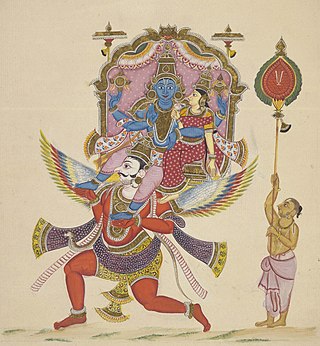
Lakshmi Narayana or Lakshmi Narayan is the dual representation of the Hindu deities Vishnu, also known as Narayana, and his consort, Lakshmi, traditionally featured in their abode, Vaikuntha. The goddess of prosperity and beauty, Lakshmi, is depicted as standing next to Vishnu, who holds the Panchajanya, Kaumodaki, Padma, and the Sudarshana Chakra. Another depiction of Lakshmi-Narayana portrays Lakshmi in the service of Narayana, who reclines on the cosmic serpent Shesha, floating in the Kshira Sagara, the Ocean of Milk.

Ayudhapurusha is the anthropomorphic depiction of a divine weapon in Hindu art. Ayudhapurushas are sometimes considered as partial incarnates of their divine owners.

In Hindu mythology, Ambarisha is an Ikshvaku king, and the son of Mandhata. He is believed to have conquered the whole world in a week. He lived during the Treta Yuga.

The Sudarshana Chakra is a divine discus, attributed to Vishnu in the Hindu scriptures. The Sudarshana Chakra is generally portrayed on the right rear hand of the four hands of Vishnu, who also holds the Panchajanya (conch), the Kaumodaki (mace), and the Padma (lotus).
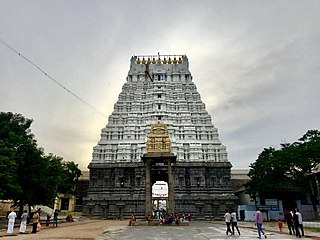
Varadharaja Perumal Temple, also called Hastagiri and Attiyuran, is a Hindu temple dedicated to Vishnu located in the city of Kanchipuram, Tamil Nadu, India. It is one of the Divya Desams, the 108 temples of Vishnu believed to have been visited by the 12 poet saints, or the Alvars. It is located in a suburb of Kanchipuram known as the Vishnu Kanchi that is a home for many famous Vishnu temples. One of the greatest Hindu scholars of Vaishnava Vishishtadvaita philosophy, Ramanuja, is believed to have resided in this temple.
Ugra Srinivasa is one of the idols in the Tirumala Venkateswara Temple at Tirumala, Andhra Pradesh. Ugra means anger and the idol which was originally called Venkatatturaivar is supposed to represent the anger aspect of Lord Venkateswara. He is also known as Snapana Murti.
Paruthiyur K. Santhanaraman is an Indian writer, Pravachan pundit, and former Deputy Treasurer of the Reserve Bank of India. Santhanaraman retired as the Deputy Treasurer of the Reserve Bank of India in Chennai after 40 years of service. He also served as a guest faculty member of the Reserve Bank of India and taught many classes on banking and HRD. Santhanaraman is also a well-known orator and author of several books and numerous articles on Tamil culture.
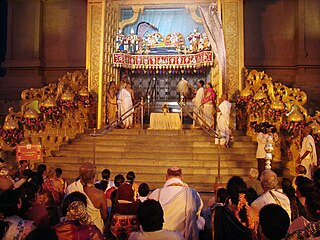
Vaikuntha Ekadashi is a Hindu occasion and festival. It is primarily observed by Vaishnavas, who regard it to be a special ekadashi. It coincides with Mokshada Ekadashi or Putrada Ekadashi. It is observed on the 11th lunar day of the waxing lunar fortnight of the solar month of Dhanu. This falls between 16 December and 13 January in the Gregorian calendar.

The Sreevallabha Temple is a highly orthodox Hindu temple dedicated to Sreevallabha, a form of Vishnu. It is one of the oldest and biggest Temples of Kerala and has been a major destination for devotees all over India for centuries. Located in Thiruvalla city, this temple is well known for its architectural grandeur and unique customs which can be found in no other temples. There are stone-wooden carvings and mural paintings inside the temple. Being one among 108 Divya Desams, Sreevallabha temple has been glorified by Alvars and many other ancient works. It is considered to be the vallabha kshethram mentioned in Garuda Purana and Matsya Purana.Kathakali is played daily in the temple as an offering, pushing it to the top in India in terms of places where Kathakali is staged on the largest number of days per year. Vishnu appeared here as Sreevallabha for sage Durvasa and Khandakarnan. Pleased by the prayers of an old Brahmin lady Sreevallabha incarnated as a Brahmachari and killed the demon Thokalaasuran. Later the deity of Sreevallabha worshipped by Lakshmi and Krishna was installed in the temple in 59 BC. From then till date, the temple follows its worship protocol that is known to be followed nowhere else yet. Sage Durvasa and Saptarishiare said to reach the temple every midnight for worshipping the Lord. The temple governed one of the biggest educational institutions in ancient times and heavily contributed to the cultural and educational developments of Kerala
Raja Mannargudi Mahamahopadhyaya Thyagaraja Mahi Raju Sastrigal, also known as Mannargudi Raju Sastri or Mannargudi Periyaval, was a Hindu scholar. He was born in the Bharadwaja Vamsa, as a descendant of Adayappaalam Sri Appayya Dikshitar. Raju Sastri was born in the village of Kuthambadi in today's Thiruvarur district as son of Maragathavalli Janakiammal and Sri Markasahaya Appa Dikshitar
The Vishahareswara Temple is a temple to Shiva in the Thiruvarur district of Tamil Nadu, India. The temple was built in the early 9th century in the village of Kodandaramapuram, which later became part of Avanam Paruthiyur, situated on the banks of the Kudamurutti River, a distributary of the Kaveri. The presiding deity of this temple is a form of Shiva called Vishahareswarar, and his consort Prasanna Parvathy Devi. The temple today is an ancient heritage symbol of the village. The temple was one of the 108 Shiva temples built by Cholan Aditya Varman 1, on the banks of the Kaveri.
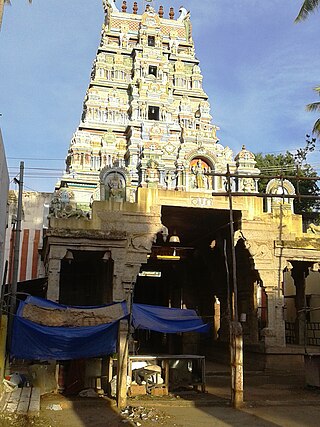
The Thirumohoor Kalamegaperumal Temple is a Hindu temple near Melur, Madurai district in the South Indian state of Tamil Nadu, is dedicated to the Hindu god Vishnu. Constructed in the Dravidian style of architecture, the temple is glorified in the Nalayira Divya Prabandham, the early medieval Tamil canon of the Alvar saints from the 6th–9th centuries CE. It is one of the 108 Divya Desams dedicated to Vishnu, who is worshipped as Kalamega Perumal and his consort Lakshmi as Mohanavalli Thayar. As per Hindu legend, the presiding deity is believed to have appeared as the divine enchantress Mohini to allure the asuras to support the devas, the celestial deities. The temple is also known as Mohanapuram and Mohanakshetram.
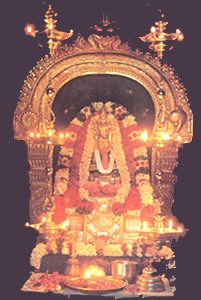
Sri Venkatesa Perumal Temple (Melathiruppathi) – Mondipalayam is counted among the noted Vishnu temples of Kongunadu. The image of the lord is flat on the four sides and conical in the center. The form was first discovered by one Kondamanaicker around 300 years ago. The devotee once sighted his cow shedding her milk on a sandhill. Induced by curiosity, he dug it, when manifested the image with Conch (Sanguchakkram) and Disc (Chakkram) as well as Saligram and Chikandi (weapon). Inspired by the divine revolution, he ordered a temple to be built up for Sri Venketachalapathi enshrining the form. Devotees who have taken vows to make offering to the lord of the seven hills can fulfill them in Mondipalayam, in the event of their inability to go to Tirupati.
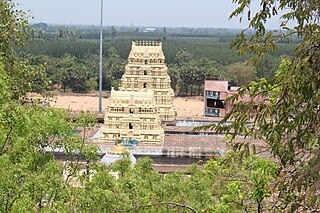
Devanatha Hemabhujavalli Temple is a Hindu temple in Thiruvanthipuram, a village in the outskirts of Cuddalore in the South Indian state of Tamil Nadu, dedicated to the god Vishnu and goddess Lakshmi. Constructed in the Dravidian style of architecture, the temple is glorified in the Nalayira Divya Prabandham, the early medieval Tamil canon of the Alvar saints from the 6th–9th centuries CE. It is one of the 108 Divya Desams dedicated to Vishnu, who is worshipped as Devanatha and Lakshmi as Hemabhujavalli. Though the presiding deity is Devanatha and Hemabhujavalli, the temple is known for Hayagriva, the ninth avatara of Vishnu in the Dashavatara of Vishnu and a god of knowledge. The temple is the only historical temple in South India to have a shrine of Hayagriva on hilltop.

Mudikondan Kothandaramar Temple is a Hindu temple located in the Tiruvarur district of Tamil Nadu, India, dedicated to Lord Rama, the seventh avatar of Lord Vishnu. The temple is glorified by Maharishi Valmiki and classified as one of the 108 Abhimana Kshethrams of the Vaishnavate tradition. The town of Mudikondan is located at a distance of 20 kilometres from Mayiladuthurai and 15 kilometres from Thiruvarur in the Nannilam taluk.This temple one of Pancha Rama Kshethrams. All these temples are said to be particular locations mentioned in Ramayana.
Varadharaja Perumal temple is a Vishnu temple located at Kaladipet in Thiruvottiyur. This temple is located near Thyagaraja Swamy temple, Thiruvottiyur. This temple was historically known as Padmapuram and is estimated to be 500 years old. Perundevi shrine is located left to that of the Lord. The shrines for Navagrahas are installed on a stage designed as lotus petal. Magizham tree is the Thala Virutcham of the temple and Vaikanasam is the pooja.

Sundararaja Perumal Temple, Salem is located on the banks of the Thirumanimutharu river at Salem, Tamil nadu, India. The temple is Classified one among the 108 Abhimana Kshethram of Vaishnavate tradition. The other significance of the temple is that it is one of the Pancha Kshethram where Maha Lakshmi was born as Bhargavi- the daughter of Maharishi Bhrigu. The other four temples of the Pancha Kshethram are Sarangapani temple, Kumbakonam, Oppiliappan temple, Nachiyar Koil and Venkateswara Temple, Tirumala. The temple is believed to be of significant antiquity with contributions at different times from Medieval Cholas, Vijayanagara Empire, Chera, Pandyas and Madurai Nayaks. The temple follows Vaikhanasa agama and the temple priests perform the pooja rituals during festivals and on a daily basis. The priests belong to the Vadakalai sect of Vaishnavism, a Brahmin sub-caste. The temple rituals are performed six times a day: Ushathkalam at 7 a.m., Kalasanthi at 8:00 a.m., Uchikalam at 12:00 p.m., Sayarakshai at 6:00 p.m., Irandamkalam at 7:00 p.m. and Ardha Jamam at 10:00 p.m. Each ritual has three steps: alangaram (decoration), neivethanam and deepa aradanai for both Ranganatha Perumal and Ranganayagi. During the last step of worship, nagaswaram and tavil are played, and religious instructions in the Vedas are recited by priests.














